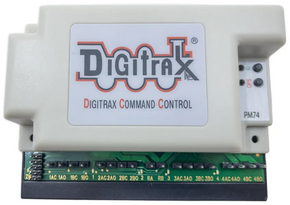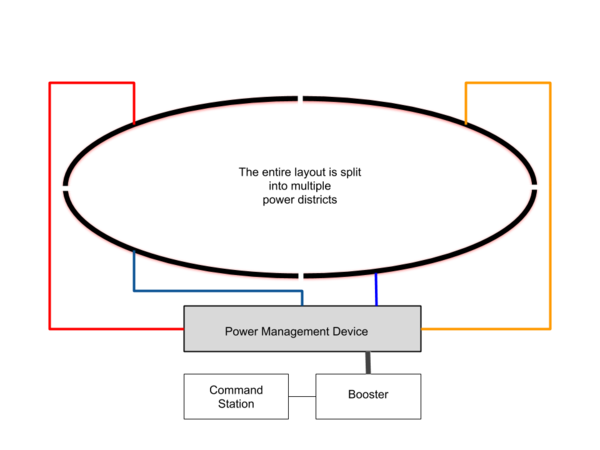PM74 Power Manager (PM74)
Power:
Digitrax: PM74 Power Manager (PM74)Summary: PM74 Power Manager with Occupancy and Transponding detection for 4 sub-districts, replacing the PM42 Quad Power Manager.
| See more Misc DCC Items | |
|---|---|

| |
| General information | |
| DCC Category Power | |
| Manufacturer | Digitrax |
| MSRP | 109 USD110.96 EUR <br />97.09 GBP <br />164.73 AUD <br />147.05 CAD <br /> |
| Compare Prices | Latest Prices |
| Manufacturer Part Number | PM74 |
| Common Name | PM74 Power Manager |
| UPC Number | 652667030120 |
| Release information
| |
| Product URL | External Product Link |
| Product Manual URL | External Product Link |
| Year Released | 2022 |
| Has computer interface | |
| Firmware Upgrade Possible | Yes |
| Predecessor | PM42 |
| Successor | |
| Misc Details | |
| Height | |
| Length | |
| Width | |
History
The previous module, PM42, was an open-air design with no cover. For good and bad, it also required a 44-pin connector to be used as the PM42 didn't allow direct connection of wires. While requiring this additional connector, it allowed for easy replacement and/or programming in a different location.
Purpose
The Digitrax PM74 is used to segment the power from a DCC booster into four separate power districts. This is useful if you have a large single booster and want to limit the short-circuit current in case of a derailment. Dividing your layout into power districts prevents the entire layout from stopping when a train causes a short in one of the districts.
The PM74 can also be used as an auto reversing unit for up to four sub-districts. Each of the four segments of the PM74 can be configured to work as either short-circuit protectors or auto-reverser, but not both at the same time. So you might for example configure a PM74 to provide three sub-districts, one of which has auto-reversing. This configuration will use all four segments of the PM74 because three are needed for protection and one for auto-reversing.
Keep in mind, a PM42 will not increase the power available for running trains over what your booster provides. It can only sub-divide the available power into smaller sub-districts.
The AutoReverse feature should not be used with a circuit breaker on the same PM74.
Analogy
Think of your booster as the main breaker in a home's breaker box (a.k.a. fuse box, or its correct term, the load center). A PM42 is like 4 individual circuit breakers - the 15 to 20 amp ones that protect everything downstream from the main breaker.
Should an overload happen on one circuit, the circuit breaker will disconnect that circuit, without interrupting power to other circuits. Or, instead of shutting down the entire layout when a short happens (and it will), only the power district with the short is shut down.
If you are using enough power to trip the main breaker constantly, then adding individual circuits won't solve anything. Likewise, a PM42 is always a good plan. Just don't expect it to take the place of additional power from another booster.
PM74 Features
- Four power management districts
- Each district configurable for Auto Reverse or [Short Circuit|short circuit]] protection
- Each district support occupancy and Transponding detection capable
- LocoNet Compatible
- Plug-in connections
- Easy setup using Option Switches or CV programming
- Power by DCC from the track or an external power supply
- Additional configuration possible using a DT602 throttle
- Allows Mainline CV Read/Write programming of compatible decoders.
- Remote LED status support.
- Series7 style advanced installation support using DT602.
What's New in PM74 vs PM42
- The PM74 is fully encased in plastic and allows for direct wiring. While the PM42 required using a female connector to which wires were connected to. The PM74 uses a removable terminal connector making setup slightly easier.
- Can operate in 'lamp mode' and can operate up to 8 lamps installed throughout the layout.
- Has a 10-pin connector that allows for multiple uses:
Installation
Read the provided installation instructions thoroughly first, and diagram what you want to do. The PM74 can be used to provide up to 4 circuit breakers, or one breaker can be configured as an |auto reverser. Or all four can be arranged as an auto reverser. As a rule, do not use an auto reverser and a breaker on the same card, as an endless loop can occur when the reverser is too slow to react and the breaker trips.
For proper operation a heavy gauge wire must be connected between the Ground connections on the booster and PM74.
LocoNet
The PM74 is a LocoNet capable device. The PM74 can transmit information such as shorts, when they are cleared, and when the autoreverser operates. Additionally, the LocoNet can interact with the 10-pin header.
PM74 FAQs
See Also
- PM42
- Short Circuit
- Power District
- Digitrax
- LocoNet
- Standalone LocoNet
- LocoNet Termination
- Power Shield X
Articles Referencing this Page
Related Digitrax Other DCC Equipment Items
- Automatic Reverser (AR1)
- BD4N
- BDL16
- BDL162 Block Detection (BDL162)
- BDL168
- BXP88
- BXPA1
- DS51K1
- Quad Stationary Decoder (DS54)
- Quad Stationary Decoder (DS64)
- Quad Switch Decoder (DS74)
- Eight Servo Accessory decoder (DS78V)
- LocoNet Repeater Module (LNRP)
- LocoNet Repeater Module (LNRP Xtra)
- LocoNet WiFi Interface (LNWI)
- LT1
- LT5
- MS100
- PM42
- PR1
- PR2
- PR3/PR3Xtra (PR3)
- PR4 Programmer (PR4)
- Pluggable Terminal Block Kit (PTBK)
- RX4
- SE74
- SE8C
- LocoNet Universal Interconnect Panel (UP5)
- UP6Z
- LocoNet Universal Panel (UP7)
- Simplex Radio Equipped/IR Receiver Panel (UR90)
- Simplex Radio Equipped/IR Receiver Panel (UR91)
- Duplex Radio Transceiver/IR Receiver Panel (UR92)
- Duplex Radio Transceiver (UR93)
